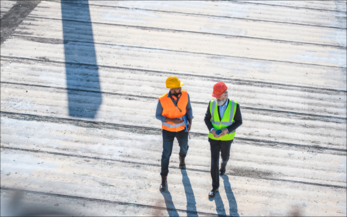6 Minutes07.08.2023
by Stefan Ganzke
Trips, slips, and falls are an often underestimated but very common type of occupational accident. Using Germany as an example, in 2021 there were more than 172,000 reportable occupational accidents due to slips, trips, and falls, i.e., accidents that result in more than three days of absence. Not only were there seven fatalities as a result of these accidents, but nearly 2,700 people became partially or completely unable to work.
How to prevent slips, trips, and falls in the workplace? – A major problem with slips, trips, and falls is that there is often a lack of awareness of the risk. For example, if an extruder’s feed points are freely accessible, a furnace in the steel industry is running at high temperatures, or if a forklift driver in logistics is driving through a warehouse, the risk is immediately apparent. On slippery floors or on stairs, however, it is more difficult for most people to recognize an acute risk to themselves or others. This makes it all the more important for companies to focus not only on regulatory compliance, but also on the safe behavior of managers and employees.





